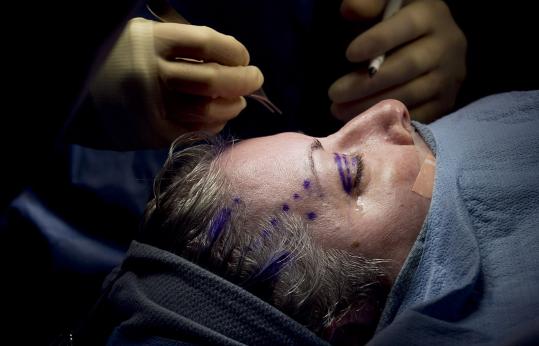An excerpt from the Boston Globe April 2012
Debra Haining lay in a hospital bed at Massachusetts General Hospital, awaiting surgery. Both eyelids were colored purple, and blue dots were drawn on her forehead, including one on each temple, and one above her left eye.
The dots indicated the location where she feels the migraine, the trigger points, where the pain strikes. She is 57 years old and says that she never had a headache until five years ago, when she woke up feeling as if she’d been shot through the head.
She was forced to spend nearly every day in bed with the curtains drawn. She could not tolerate light, smell, or sound. Typically she rose only to see her 12-year-old son off to school in the morning and in the afternoon when he returned. Until recently, she had an ice pack to her head and could not drive a car.
A half-dozen medications, four different pain clinics, a variety of headache cocktails and injections, and numerous neurologists didn’t provide relief. Haining, who lives in Pawtucket, R.I., searched the Internet until she found Dr. W.G. (Jay) Austen Jr., of plastic and reconstructive surgery at Massachusetts General Hospital.
Haining says she was tired of doctors who suggested that she learn to accept a lifetime of pain, pills, and shots, and was relieved to find a doctor who offered to treat the cause of the migraine and not just the symptoms. “When you are debilitated and life comes to a halt, you are willing to try what’s out there.’’
In the operating room at Mass. General, Austen began surgery on Haining by making an incision in one of her eyelids in what would appear to be a routine blepharoplasty, a cosmetic surgery known as an “eyelid lift.”
Haining would benefit cosmetically by removal of this globular flat that settles into each eyelid with age. But the point, Austen says, is that this particular procedure provides “easy access” to the critical sensory nerves around her eyes that he believes were causing migraine pain.
This was just one of the three trigger points that Haining identified prior to surgery, and as he operated, Austen would be seeking a structural reason for that pain, a nerve compressed or impinged by surrounding bone or soft tissue.
This surgical approach was developed 12 years ago by Dr. Bahman Guyuron, chairman of the plastic surgery department at University Hospitals Case Medical Center in Cleveland, after several of his plastic surgery patients reported that their migraines improved after a cosmetic procedure known as a forehead lift.
A study published in the journal Plastic and Reconstructive Surgery in 2009 — led by Guyuron and submitted by Case Western Reserve University, the American Migraine Center, and the Center for Headache and Pain, Cleveland Clinic — found that just under 85 percent of patients who underwent the nerve decompression surgery reported at least a 50 percent reduction in migraine, calculating pain, frequency, and duration. Nearly 60 percent (28 of 49 patients) reported a complete elimination of pain. This compared with only 1 of 26 patients who had a sham surgery, in which the surgery was limited to exposure of the nerve but muscle and attachments were left intact. Reported side effects included forehead numbness, temporary hair loss and itching, a slight hollowing of the temple, and small change in eyebrow movement.
xx
Sound too good to be true?
Dr. Paul Mathew, neurologist at Harvard Medical School and fellow graduate of the 2014 AAN Palatucci Advocacy Leadership Program says yes….
In his recently published review on the subject, Dr Mathew explains that these surgeries are unproven, risky, expensive ($10,000-15,000) and are often not covered by medical insurance. “Many patients have no or temporary benefits from the surgery and still wind up on long term narcotics”, he says, and furthermore “These procedures have made their way into mainstream medicine without adequate investigation”. This is why he has decided to make this subject the focus of his future advocacy efforts.
Click here to read the paper.
Click here to find out more about migraine.
